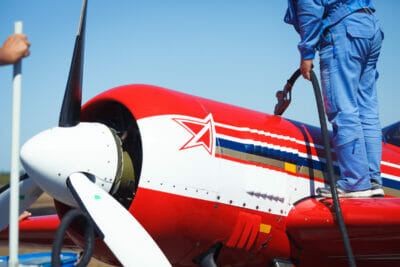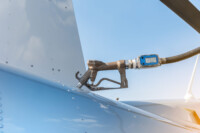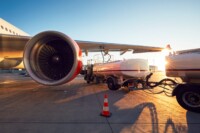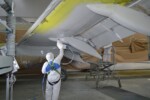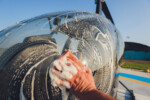What Type of Fuel Do Airplanes Use?
22 April 2022 | Updated on February 05, 2024
Flying is an essential part of our lives affecting how we conduct business, organize family trips, and plan our vacations. We rely on airplanes as the primary mode of air transport, and the demand for commercial air transport is rising to historical highs after a slight dip caused by the COVID 19 global pandemic.
Airplanes, just like all machines, run on petroleum-derived fuels and synthetic fuels. We know that jumbo jets and other passenger and light aircraft do not roll into your local gas station to fill their tanks with unleaded super.
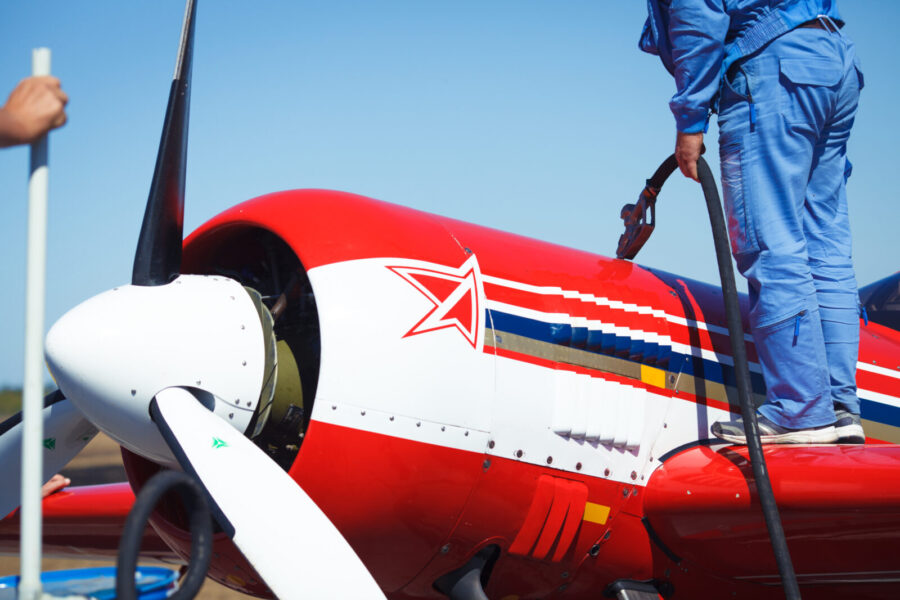

Important Disclaimer: The information and data provided here are for informational purposes only, and are subject to change over time. We strive to provide the most current and relevant information, but the dynamic nature of the topics discussed may result in changes that are not immediately reflected in our content. We recommend our readers to conduct their own research and consult with professionals when making significant decisions based on the data or information provided here. Your reliance on the information in this post is solely at your own risk.
Readers should know a plane’s fuel type is determined by the sort of engine it has and not by the airplane size. Single and twin-piston engine aircraft use Aviation Fuel AVGAS, while turboprops, commercial airliners, and most military aircraft use kerosene-based Jet Fuels.
This post answers all your questions concerning the two basic airplane fuel types, their distinctions, and sustainable airplane fuels, promising hope for a greener future.
What Type of Fuel do Airplanes Use?
Airplanes use two types of fuel depending on their engine. These include Jet Fuel, a kerosene-based fuel grade, and Aviation Fuel (AVGAS), similar to vehicle gasoline.
Individuals who own private jets or their lesser turboprop cousins pay for Jet Fuel at the gas pump. While ordinary folks who could only afford piston-engine airplanes usually roll out AVGAS drums at fuelling time. Other alternative fuel types like the military-grade JP-4, equal kerosene and gasoline blend exist but are not as widespread as the first two.
Airplane fuels consist of unique chemical compounds influencing production, storage capability, pricing, and burn rates. Jet Fuel is a fast-burning fuel type used in jet turbine and turbo-prop engine aircraft. And while AVGAS is slower burning, it is significantly more expensive than Jet Fuel.
Jet Fuel
Jet Fuel is a non-volatile, compression fuel powering aircraft jet turbines and turboprop engines. It is easily distinguishable by its clear color and distinct diesel-like smell. Jet Fuel is available in over ten different grades formulated for general aviation and military aircraft, with Jet-A and Jet-A1 being the most common.
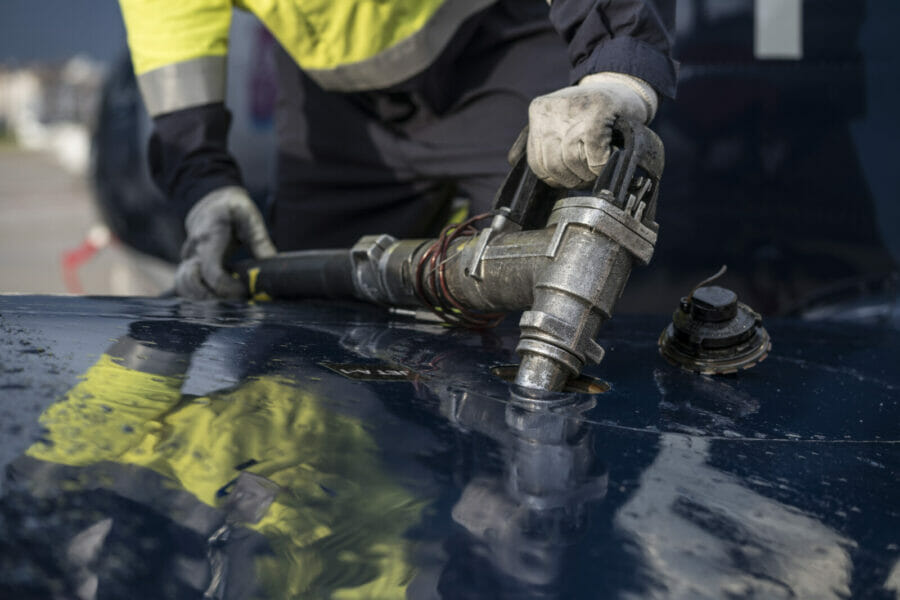

The different grades of Jet Fuel include
- Jet-A – is the most common Jet Fuel type in the United States, with a higher ignition point (38°C) and lower freezing point (-40°C) than kerosene.
- Jet-A1 – has a much lower freezing point (-47°C) than Jet-A making it suitable for colder climes and international aviation. It typically contains additives and dissipaters that reduce static charges during transportation.
- Jet B – has the lowest freezing point of -76°C, making it a perfect substitute for Jet-A and Jet-A1 in frigid climates.
Military-based Jet Fuels
- JP-1 – is an early type of pure kerosene Jet Fuel grade created for the United States military. It has a high flash point with an extremely low freezing point (-76°F).
- JP-2 – is an outdated Jet Fuel grade formulated to replace JP-1 Jet Fuel grade. Its significant benefits over JP-1 include a higher freezing point and easier production.
- JP-3 – is a more improved version of the JP-1 Jet Fuel grade. It has severe deficiencies in service, including high volatility and high evaporation loss.
- JP-4 – is also known as AVTAG and was the preferred Jet Fuel grade for the United States Air Force for over forty years. It consists of equal gasoline and kerosene mixture with a transparent color similar to kerosene. JP-4 has a low flash point and is readily available.
- JP-5 – known as Aviation Carrier Turbine Fuel (AVCAT) or NCI-C54784. It is a kerosene-based Jet Fuel grade formulated for carrier-based aircraft. JP-5 has a yellow color with a complex blend of hydrocarbons and a high flashpoint.
- JP-6 – is a unique blend of Jet Fuel formulated for the afterburning turbojet General Electric YJ-93 engines used on the XB-70 Valkyrie supersonic strategic nuclear bomber. It shares similar characteristics with the JP-5 Jet Fuel grade except for improved thermal-oxidative stability levels and a higher -65°F freeze point.
- JP-7 – specifically developed for the Lockheed SR-71 Blackbird. The JP-7 jet fuel grade possesses high thermal stability and a high flash point preventing the effects of aerodynamic heating.
- JP-8 – is a kerosene-based fuel sharing several similar characteristics to the Jet-A1 fuel used by commercial airliners. The United States military commonly uses JP-8 Jet Fuel grade in aircraft, diesel trucks, and military ground vehicles.
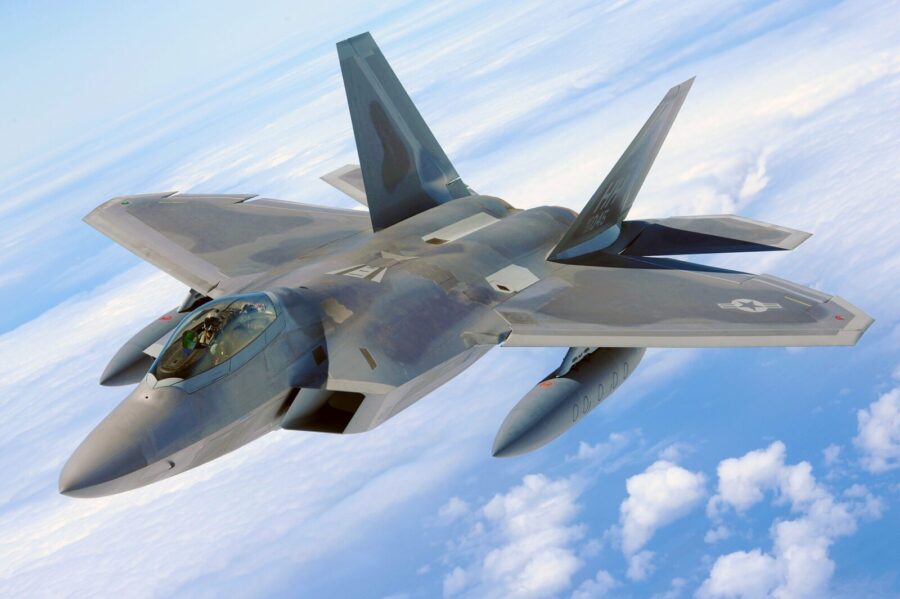

Aviation Gas (AVGAS)
Aviation Gas (AVGAS) is the second most common airplane fuel type globally, with the 100LL (One Hundred Low Lead) being the most widespread AVGAS grade. AVGAS is blue with a similar chemical compound to vehicle gasoline because it is formulated for piston-engine aircraft. However, using AVGAS in a conventional automobile engine will damage vital engine components (e.g., catalytic converter) because it is a high octane fuel type containing 0.56gm of TetraEthyl Lead per liter (thrice the amount of lead found in vehicle gasoline).
AVGAS provides airplane high compression piston engines with exceptional performance at any altitude. Oil and gas companies producing AVGAS add TetraEthyl lead additives to protect engine components and avoid engine knock or detonation.
Are Biofuels the future?
Biofuels are alternatives to traditional fossil fuels like Jet Fuel and AVGAS. Generally known as Sustainable Aviation Fuel (SAF), they are a renewable energy source produced from viable organic sources (biomass). Examples include plants, waste oils, camelina, palm oil, and ethanol.
There are several processes for extracting liquid airplane biofuel from solid biomass, and aircraft engines do not need modifications to run on SAFs. In 2008, a Virgin Atlantic Boeing 787 Dreamliner powered by a Jet Fuel and brassica carinata (an industrial mustard seed) derived biofuel mixture flew from the United States to Australia in what became aviation’s first biofuel commercial flight.
SAFs produce lower carbon emissions than fossil fuels while offering comparable efficiency levels. And they can be easily integrated into existing fuel architecture without the need to build a separate infrastructure.
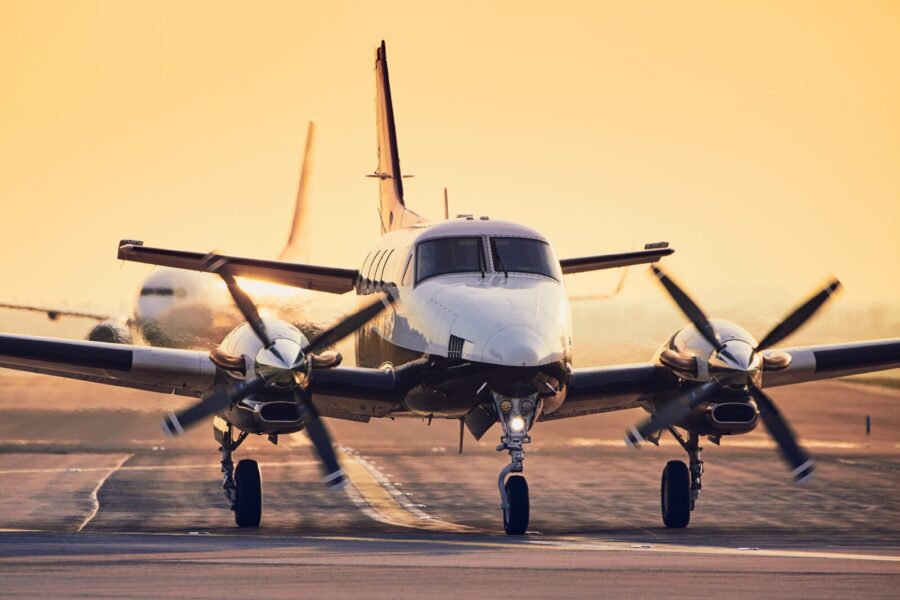

Differences between Jet Fuel and Aviation Gas
There are distinctive differences between Jet Fuel and AVGAS. Many of these differences are hidden, while a few are noticeable.
The table below describes the differences.
| Jet Fuel | Aviation Gas |
| Jet Fuel is less volatile, with a spark-ignition temperature of over 38°C and an autoignition temperature of 246°C. | Highly volatile with a flashpoint of -43°C and an autoignition temperature of 246°C. |
| Jet-A1(USA) has a low freezing point of -47°C, while Jet-A (international) has a lower freezing point of -40°C. Jet-B and TS-1 Jet Fuel grades have freezing points of over -50°C. | AVGAS freezing point is about -100°C. |
| Jet Fuel has a fast burn rate in jet engines, a reason why airplanes carry lots of the stuff in their tanks. | AVGAS has a slower burn rate in piston engines. |
| Jet Fuel is cheaper to produce because it is created earlier during the distillation process. | AVGAS production is more costly. It is created later in the distillation process after undergoing several refining stages. |
| Jet Fuel is the primary fuel option of the military, large aircraft companies, and commercial airlines operating large passenger and cargo jets. | It is exclusively used for small piston engine light aircraft typically used for crop dusting, training, aerobatics, and personal transportation. |
| Jet Fuel contains stable chemical compounds making it a safe material to transport and store in large quantities. | Aviation experts do not recommend storing or transporting massive amounts of AVGAS unless specific safety protocols are observed. |
| Jet Fuel demand is restricted to jet engines and turboprop aircraft. However, it is sold in much larger quantities than AVGAS. | Fewer quantities of AVGAS are sold globally compared to Jet Fuel despite more considerable numbers of aircraft using it. |
| Jet Fuel has anti-corrosive additives, de-icing agents, and anti-static chemicals, improving its safety while protecting engines and reducing accidents. | AVGAS possesses filtered anti-knock properties minimizing spark plug damage and an appropriate blend of chemical mixtures required for optimum take-off performance and high-altitude cruising efficiency. |
What is Added to Airplane Fuel?
Over two thousand chemical compounds are added to aviation fuels during production to improve their efficiency in airplanes. These include hydrocarbons like n-heptane and isooctane.
Adding additives to airplane fuels is a highly regulated process involving extensive testing and evaluation before an additive is certified for use. While additives are standard in AVGAS, the use of additives in Jet Fuel is determined if the fuel is civil or military-grade.
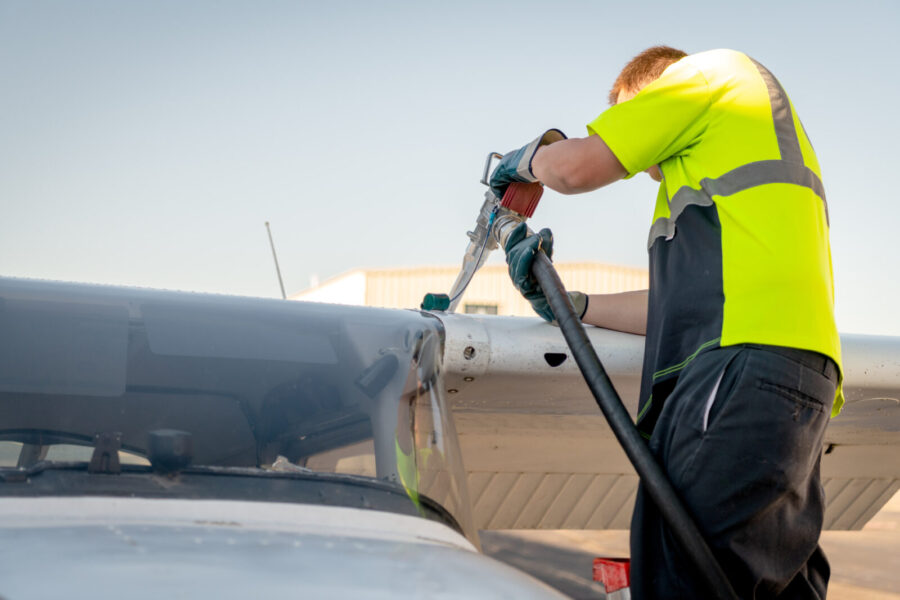

Types of airplane fuel additives
- Antioxidants – or gum inhibitors are additives formulated to control gum formation in airplane engines by lengthening the induction period and eliminating free chain reactions commonly found in the oxidation of hydrocarbons. Antioxidants are used in Jet Fuels and AVGAS.
- Corrosion inhibitors – reduce corrosion rate in the metals and alloys used for jet turbine engines in civil and military planes and improve the lubricity of Jet Fuels. They work by forming a passivation layer preventing oxygenates in airplane fuel from touching engine metal parts.
- Metal deactivators – improve airplane fuel thermal stability by weakening the catalytic effect of disintegrated trace metals.
- Static dissipaters – are aviation turbine engine fuel additives formulated to prevent the build-up of dangerous static charges during the pumping or transfer of Jet Fuels.
- Antifreeze – work by reducing the freezing point of any moisture in the fuel tanks preventing the formation of ice crystals that could potentially reduce fuel flow to the engine.
- Tetraethyl lead – is commonly used in AVGAS to increase its anti-knock properties. It is an octane rating booster allowing higher compression engines in airplanes.
How Much Fuel Does an Airplane Consume?
Everyone knows airplanes consume more fuel than ordinary cars and trucks do. But to measure an airplane’s fuel consumption requires you to take into account its size, its flight distance, and its function. You may need to take a quick look at the size of an airplane fuel tank too. A small Piper Cub plane fueled from 57.8 gallons (218.7 liters) AVGAS drums will consume less fuel than a 747 Jumbo jet fueled by two 10,000 liter aviation trucks!
While it is evident that a Boeing 747 consumes more fuel than a Piper Cub airplane, the fact that a 747 can carry up to three hundred and fifty passengers and over a hundred thousand pounds (45,359 kg) extra weight nonstop from Los Angeles to Melbourne, Australia helps to put things in proper perspective.
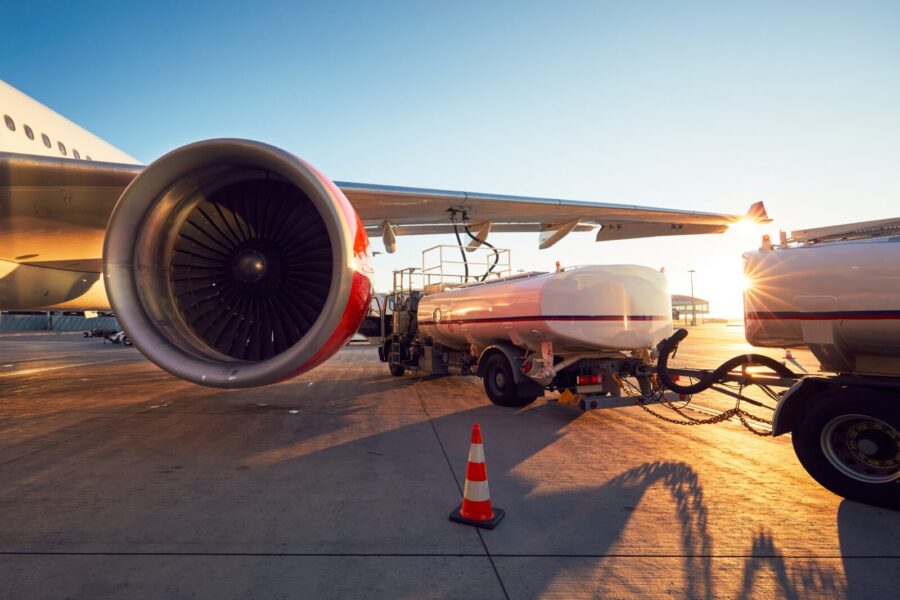

A plane’s range, number of engines, and efficiency, including its fuel type, are the most significant indicators of its fuel consumption. Below is a table illustrating the fuel consumption of airplanes with different engines and fuel types.
Fuel consumption of piston-engine airplanes
| Model | Number of engines | Number of seats | Fuel Consumption (Gal/Hr) |
| Aeromarine Merlin PSA | 1 | 1 | 2.5 |
| Cessna 172P | 1 | 4 | 7 |
| Piper PA44 Seminole | 2 | 4 | 20-22 |
| Beech G58 Baron | 2 | 6 | 22 |
Fuel consumption of turboprop airplanes
| Model | Number of engines | Number of seats | Fuel Consumption (Gal/Hr) |
| Pilatus PC-12 NG | 1 | 9 | 70.20 |
| Piper Cheyenne II | 2 | 6 | 72.3 |
| De Havilland Dash 8-100 | 2 | 37 | 158.5 |
| Embraer ATR 72-500 | 2 | 78 | 279.70 |
Fuel consumption of jet airplanes
| Model | Number of engines | Number of seats | Fuel Consumption (Gal/Hr) |
| HondaJet HA-420 | 2 | 5 | 90 |
| Gulfstream G600 | 2 | 19 | 458 |
| Boeing 737 MAX | 2 | 172-210 | 750 |
| Airbus A380 | 4 | 544-868 | 4,405 |
Military airplane’s fuel consumption
| Model | Number of engines | Payload | Fuel Consumption (Gal/Hr) |
| Lockheed C-130 | 4 | 19,958 kg | 740-1,185 |
| F-22 Raptor | 2 | 20,000 kg | 3,000 |
| Boeing C-17 Globemaster | 4 | 77,519 kg | 3,329.90 |
| B-52 Bomber | 8 | 31,751 kg | 3,300 |
Can an Airplane Run on Diesel Fuel?
Jet planes could run on diesel fuel in theory since both Jet Fuel and diesel have similar chemical properties. But it wouldn’t work out so well in real life due to how current jet turbine engines are designed and the limitations of diesel fuel as an airplane fuel.
Here are a few reasons why airplanes can not run on diesel fuel.
- Engine weight issues – the average jet turbine engine is significantly lighter than a piston mill with similar power output. A diesel piston engine adds an extra layer of complexity, with additional parts adding to the plane’s overall weight.
- Diesel is heavy – airplane manufacturers are constantly finding new ways to make airframes lighter for more fuel efficiency, and designing planes to run on diesel fuel will make that more difficult. You might point out that diesel is way denser and contains twice as much energy as Jet Fuel and AVGAS. However, a plane running on diesel fuel has a decreased passenger payload than a Jet Fuel-powered plane of similar size.
- Diesel fuel is dirty – anyone who followed a large diesel rig on the highway can’t help but notice thick black smoke billowing from the exhaust. Exhaust soot particles are a problem common in diesel engines and less common in gas or jet turbine engines. According to a 2002 New Scientist article. Carbon particles from diesel engines will warm the planet faster than other fuels over the next century.
- Complexity – modifying an airplane engine to run on diesel requires many additional engine parts, adding an extra layer of complexity.
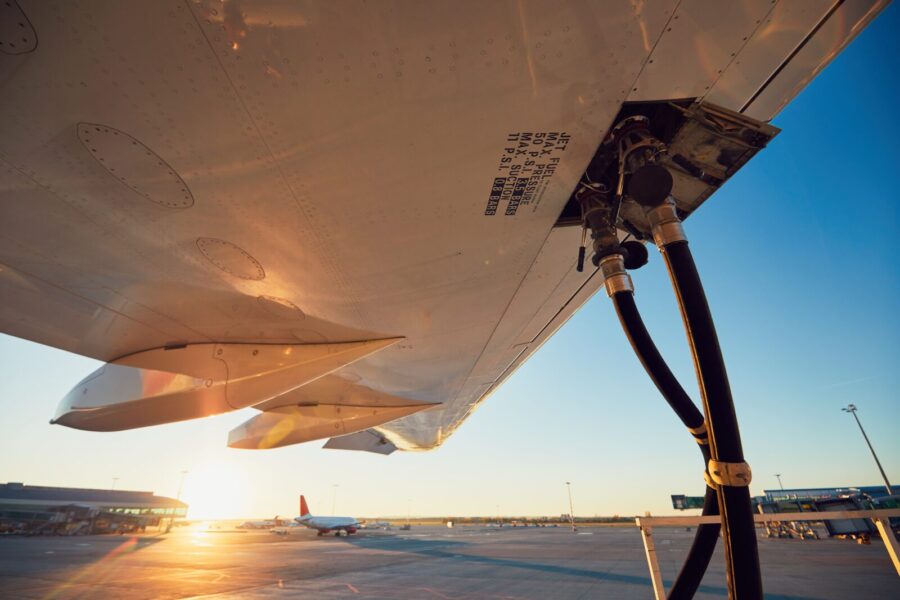

Where is an Airplane Fuel Tank Located?
I bet you never guessed, but airplane tanks are commonly located in the wing structure or fuselage. Some planes have fuel tanks installed in the rear, and large commercial airliners can have up to three fuel tanks in different sections of their airframe.
Wing and fuselage fuel tanks are called integral fuel tanks because they form a part of the airframe structure. They have a typical lifespan of around 30 years.
Airplanes can carry additional fuel in extra fuel tanks around the airframe. Some of these fuel tanks are external tanks.
They include
- Rigid fuel tank – It is a removable aluminum alloy or stainless-steel tank installed in a special chamber explicitly built to hold it. Airplane technicians can remove rigid fuel tanks during servicing.
- Bladder fuel tank – A bladder fuel tank is a large rubberized bag that can be rolled up and installed inside a special chamber inside the airframe. A bladder tank is made from reinforced rubber compounds and, when installed in an airplane, can be accessed through an access panel or fuel filler neck.
- Drop fuel tank – A drop fuel tank, also called an auxiliary tank, is an external fuel tank carried on a plane’s wings to increase its range. All fuel inside drop tanks is used up first before transitioning to the internal tanks. Drop tanks are jettisoned mid-flight once they are empty, and this tank type is commonly used by military planes.
- Conformal fuel tank – It is similar to a drop fuel tank with widespread use within military airplanes. However, a conformal fuel tank can not be discarded in-flight when empty. A conformal fuel can be removed only when the plane is on the ground.
How Much Fuel Can an Airplane Hold in Its Tanks?
Airplanes take a lot more fuel than cars and trucks do. But large commercial airliners can take on a staggering amount of fuel in their large tanks, as anyone who has seen a Boeing 747 refuel can attest.
Small passenger planes like the Beechcraft 1900D can carry around 665 gallons (4,458 Ibs) of fuel. In contrast, the Airbus A300 Beluga cargo plane can take ten times more fuel at 6,303 gallons (42,230 Lbs).
| Airplane Model | Fuel Capacity (Gallons) | Fuel Capacity (Pounds) |
| Cessna Citation V | 861 | 5,771 |
| Gulfstream G500 | 4,514 | 30,250 |
| Boeing 737 MAX | 6,853 | 45,915 |
| BAC Concorde | 31,483 | 210,940 |
| Boeing 787-10 | 33,384 | 223,673 |
| Airbus A350-1000 | 41,948 | 274,808 |
| Boeing 747-800 | 63,034 | 422,327 |
| Airbus A380 | 85,472 | 559,937 |
| Antonov AN-225 | 98,656 | 661,400 |
Conclusion
We have learned that airplanes run on Jet Fuel, Aviation Gas, kerosene and gasoline blends, and biofuels. Jet Fuels have a higher flashpoint and a lower freezing point than AVGAS. Plus, it is cheaper with a higher burn rate. Large civil and military airplanes use Jet Fuel, while smaller general aviation planes run exclusively on AVGAS.
Biofuels may become the airplane fuel of the future due to fewer emissions and environmentally friendly production.




















